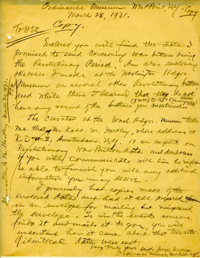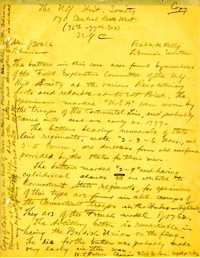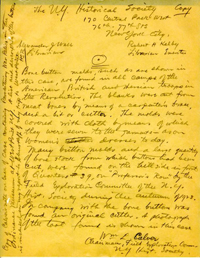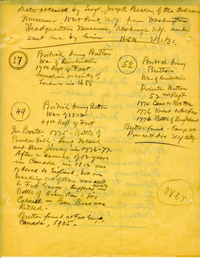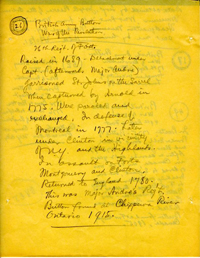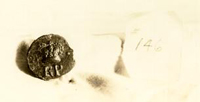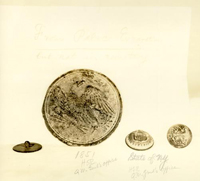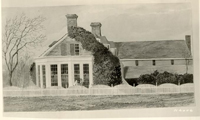Governor's Palace Historical Report, Block 20 Building 3Originally entitled: "Examination and Identification of
Buttons Found in Graves in Cemetery"
Colonial Williamsburg Foundation Library Research Report Series - 1481
Colonial Williamsburg Foundation Library
Williamsburg, Virginia
1990
From: H. S. Ragland
Subject: Buttons - Cemetery. Report of additional Research work done in Quarter Master General's Office, Washington, D. C. and in Museum, United States Military Academy, West Point, N. Y. for Identification of Buttons found in the Cemetery, supplementing report on "Examination and Identification of Buttons etc." dated November 30, 1930.
Date: March 24, 1931
On Saturday March 14th, I talked with Mr. Dubois, of the Quarter Master General's Office in charge of the records and museum of Army insignia, uniforms and equipment, who was sick when I examined records in his office last November. However, he had no data about revolutionary buttons that his clerk had not shown me on my previous visit, but I think it was worth while talking to him personally about the buttons found in the Cemetery, for he made notes concerning the unidentified buttons with the following designs, "5MM" "RIR" and the "Cavalrymen", and said that in the course of his research work he would try to find some data about them and would promptly send us anything he might find. He told me that the design of our second 2 button on Photograph # 6 is known as an "Escarbuncle" and that it is the design which was originally used in heraldry to strengthen the shields of armor and later became a charge on the warrior's shield in the development of a coat-of-arms.
He said that the button with the word "Excelsior" on it, shown in our photograph of "Buttons found in Palace Excavations but not in the cemetery", is the button worn by the National Guard of New York in the Spanish-American War, 1898. He did not date the other button shown on the same photograph but said it was modern. The military ornament with design of an eagle holding olive branch in one claw and arrows in the other, shown on the same photograph is a cartridge box belt plate of 1861. Mr. Dubois showed me an exact replica of it in "Regulations for the Uniform and Dress of the Army of the United States June 1851", a catalogue of William H. Horstmann & Sons, Military Furnishers of Philadelphia, approved as official by J. R. Jones, Adjutant General, Washington, June 1851. Mr. Dubois was interested in our work and assured me of his co-operation with us at any time. He said that he would appreciate it very much if we would let him have a copy of the photographs of the buttons found here with the data concerning them, for his files, as it is by such means that he collects his data, which in turn he makes available to any one doing research work. As it was through the assistance of his office last November and data on file there 3 that we identified and dated many of our buttons, I hope that you can send him copies of the photographs and notes.
On Saturday March 21st, I examined the collection of "Revolutionary war Relies" including buttons, and all the other military buttons in the Museum at the United States Military Academy, West Point, New York, but found none like our "5MM" "RIR" or the "Cavalryman". However, there were nine "USA" buttons, in the Revolutionary Collection like ours, shown in our photograph # 125, and four plain Revolutionary buttons like ours shown in photograph # 115. The Revolutionary Collection also included the following buttons:
 We have none similar to these.
We have none similar to these.
Some of the Revolutionary buttons and relics were presented to the Military Academy by the New York Historical Society (Mr. V. L. Calver) and others by Mr. Regineld Bolton. A copy of Mr. Calver's statement concerning the Collection is attached. It is interesting to note that the bone buttons described by Mr. Calver, which are similar to ours, were made by the soldiers of the Revolution in the field from meat bones, and that pieces of cloth were wrapped around them by which the buttons were sewed to the uniforms.
Our metal cuff link, found in Grave No. 84 is like one in the West Point Revolutionary Collection which is labeled "Officer's cuff link".
The buttons in the West Point Collection labeled "Hessian" are plain and pewter and in section look like this 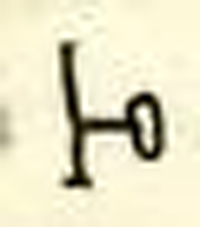 . There were also a few small plain slightly oval pewter gaiter buttons. Our small buttons are not exactly like them but resemble them sufficiently I think to possibly have been used for the same purpose. There were also flints and belt buckles very much like our buckle found in grave No. 116, and a back of button labeled "Officer's button" which in section looked like this
. There were also a few small plain slightly oval pewter gaiter buttons. Our small buttons are not exactly like them but resemble them sufficiently I think to possibly have been used for the same purpose. There were also flints and belt buckles very much like our buckle found in grave No. 116, and a back of button labeled "Officer's button" which in section looked like this 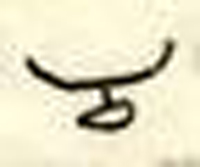 and is somewhat like one in our collection, found in grave No. 98.
and is somewhat like one in our collection, found in grave No. 98.
The West Point Collection of Military Buttons of all Wars later than the Revolution bear no resemblance at all to any of our buttons found in the cemetery. On the other hand, the West Point Collection of Revolutionary Relies is additional proof that our buttons found in the Cemetery were 5 worn by soldiers in the Revolution, and my examination of the collection confirms my belief that all of our buttons, and other articles found in the graves are "Revolutionary" and that all the skeletons are the remains of soldiers of both sides that fought in the War of the Revolution 1775-1783.
Herbert S. Ragland
In charge of Archaeological Excavations.
HSR/vbl
From: H. S. Ragland, in charge of Archaeological Excavations.
Subject: Report on Examination and Identification of Buttons found in Graves in Cemetery, located in area between Tyler Street and Navine, Scotland street and Williamsburg Laundry Building, Williamsburg, Virginia.
Date: November 30, 1030 — Williamsburg, Virginia.
Note: See Report of Dr. Erdlicka's examination of skeletons. See H. S. Ragland's report on Cemetery & Map.
Buttons were found in the Cemetery in 39 of the 158 graves, all of which were excavated and examined. Some of the buttons are plain and made of bone, but the majority of them are made of pewter and are solid, with several Military designs and initials & numbers on them. The buttons from 32 graves and objects from 4 others are now in 36 envelopes, filed in your office, (having been removed from the bags mentioned in the report on the cemetery), the numbers on the envelopes corresponding with the numbers of the graves in which the buttons were found. The numbers are as follows:- 4, 6, 10, 11, 16, 19, 20, 32, 34, 35, 55, 56, 58, 61, 64, 70, 73, 79, 80, 83, 84, 85, 87, 98, 95, 98, 99, 104, 105, 106, 109, 115, 123, 124, 146, 156. The best samples of the buttons and the most decipherable designs of initials and numbers are in envelops numbered 4, 6, 11, 34, 67, 98, 99, 104, 115, 123, 146, 156. The other envelopes contain duplicates and badly corroded buttons.
Corroded fragments of buttons found in graves, 2, 3, 25, 47, 52, 125, and 155 were left in the bags filled in the high school. Articles found in graves 46, 28, 38, 108, 116 and 136 were also left in the school.
I took these buttons to Washington and compared them with photographs and illustrations of old buttons in the National Museum and in the Quartermaster General's Office, and examined. The skulls were removed from graves 62 and 151 and were put in the school. Hand made nails were found in 98 of the 158 graves. See [illegible] 2 much data in both of those offices and also in the Old Records Division of the Adjutant General's Office with the following results-
The U. S. A. buttons, samples of which are in envelopes numbered 11, 34, 55, 95, 98, 105, 109, 123 and 124 I have identified as military buttons worn by American Soldiers in the Revolution. The button with the Crown and R. P. on it in envelope # 146 I have identified as a British (Tory) Revolutionary button, worn by the Royal Provincials.
These buttons were identified by illustrations and descriptions in the Catalogue of "The Emilio Collection of Military Buttons - American, British, French and Spanish, with some of other countries, and non-military in the Museum of the Essex Institute, Salem, Massachusetts. A descriptive catalogue with historical notes and ten plates illustrating 240 important specimens by Luis Fenollosa Emilio, Captain, U. S. Volunteers 1863-1865", published by The Essex Institute, Salem, Massachusetts, 1911. This catalogue was considered, both by Mr. Theodore T. Bellote, Curator of history and Captain Carey of the U. S. National Museum, and by the Quartermaster General's Office (Mr. Dubois) the best authority on military buttons, and the collection itself the best of its kind in America. Copies of the Catalogue are in both the National Museum and the Quarter-Master General's Office.
The picture of button no 2, Plate 1, page 18, and the description of it on page 2 of the Emilio Collection Catalogue is exactly like it and perfectly describes the U. S. A. buttons found in graves numbered 34, 55, 95, 98, 105, 109, 123, and 124 in the Cemetery in Williamsburg. The description listed 3 under Chapter entitled "American — War of Revolution 1775-1783," heading at the top of page & reading "United States — War of Revolution," Follows:-
"No. 2. Army, General Service; solid flat; pewter; 18. U. S. A. 8mm. high, entwined, See Plate 1. "The U. S. A. buttons in the Emilio Collection of the size just described were found near "9th. Avenue and 201st. Street New York City, the site of a British Camp during the American Revolution."
The description of button No. 1, page 2 of the Emilio Collection Catalogue perfectly describes the U. S. A. button found in grave No. 11 in the cemetery in Williamsburg. No picture of the button was shown. The description, under "United States - War of Revolution" follows:-
"No. 1. Army, General Service; construction, solid; the face flat; material, pewter; diameter in millimeters, 22. U. S. A., 10 mm. high entwined. - From Fort George, Niagara River, Canada." The Catalogue further records, "Military buttons are very often found on ground occupied by the adversaries. All about old Fort George were the Crown lends settled upon by loyalists of the American Revolution and notably by Butler's Rangers. This style of button of the Continental Army is the one more frequently found than any other, and in many different localities."
The picture of button No582 (Emilio Collection) Plate 5, opposite page 118 of the Catalogue and the description of it on page 104 is exactly like and perfectly describes the button with the "Crown" and "RIR" on it found in grave No. 146, in the Cemetery in Williamsburg. The description of button No. 582, Under the Chapter "Great Britain — American Revolution," follows:-
"582, British provincials; solid; flat; pewter; 25. The letters "R[illegible]" in relief 5 mm. high, surmounted by a Crown."
"From British Camp, 210th. Street and 10th. Avenue New York City. A general service button of the loyalist soldiers who are referred to as 'Royal Provincials.' These buttons were 4 probably on the yearly supply of thousands of uniforms made by contract in England and sent to America for all the loyal enlisted men or organizations, except those forming the very few loyalist corps that had regimental buttons. The uniform was first green, the coat faced with white, and cocked hats with white binding around. Later in the war the uniforms were changed in color to red as a prelude to their being drafted into British regiments, if so ordered."
The following extracts, from the Emilio Collection Catalogue, supply data concerning other military buttons.
Under United States — War of the Revolution, page 2.
"No. 4. Army, 1st. Connecticut (Continental) solid; flat; lead; 15. "I" above letters "CR", 5mm. high. See Plate 1. Modern cast from a mold found in Hartford, Connecticut. From Bristol, R. I., where the mold was owned until recently.""The Continental Army was composed of State Regiments and their buttons, when uniforms were provided were distinctive, numbered, of pewter and crudely cast."
Page 3.
"No. 5. Militia; solid; flat; copper; 34. 16 Rays enclosed in scalloped border - From Century House, 205th. Street, New York City, where many Revolutionary Relics have been found. It was on the Harlem River bank, was built in 1754 and standing until recent years and lately used as a river-side hostelry. The men raised for limited terms of service were generally clothed in their ordinary costumes, buttons and all."Page 3.
"No. G. Militia; solid; flat; bronze; with 10 perforations: 27. In Center, a mullet surrounded by 5 foliate designs in relief.—From near site of old Fort William Henry, Lake George, New York. Possibly a button of the French War; but the whole region was occupied militarily during that and the War of the American Revolution.""No. 7. Militia (?); filled; convex; bronze; 15; probably made in France.—From old Crown works at Crown Point, New York."
5"No. 8. Militia (?); solid; flat; bronze; £0. 9 stars in lines crossing diagonally."
"No. 9. Militia (?); solid; flat; pewter; 18. Surfaced lettered "Liberty" in 5 lines - From Niagara Frontier."
"Page 1 — American War of Revolution, 1775-1785. Previous to this period there were few military organizations, generally in the larger communities, which had distinctive uniforms with white or yellow metal buttons. The Militia as a rule were in civilian clothes under arms, and in such garb took part in the actions at Lexington and Concord and gathered for the siege of Boston."
"By 1767 the dress regulations of the British Army had prescribed that the regimental buttons should be numbered and following that precedent, on July 5, 1775, the Massachusetts Provincial Congress decreed that the Coats of the State regiments should have pewter buttons with the number stamped on the face thereof. The Congress, on November 4th. of the same year, ordered the Colonels of the new (Continental) Establishment to arrange with the Quartermaster General of the Army for the uniforms of their respective state regiments `that the buttons may be properly numbered'. Probably there was great delay in complying with these orders for cloth suitable for uniforms was scarce and it was not until early in 1777 that supplies of clothing began to arrive from France. Many of the Massachusetts Militia completed their term of service without receiving from the state the promised "bounty coat" with numbered buttons. It has been claimed that the French clothing received had buttons with special devices, but in view of the fast that there were first and last some 5[illegible] state regiments of all arms on the Continental Establishment, for each of which distinctive buttons seem to have been prescribed, it is improbable that the French clothing, of which shipments of 20,000 and 25,000 suits were made had other than some buttons for general use.
General Washington by orders of October 2nd., 1779, prescribed the uniforms for troops of the thirteen states respectively, and provided that the buttons of the infantry and light dragoons be white and those of the artillery and artillery artificers, yellow. General Howe, in his orders to the Massachusetts line, dated Jany. 5th., 1781, fixing the uniform, directed that the number of 6 each regiment be in the center of the buttons and such device also as the field officers should prescribe."
(Note -"General Service" means buttons worn by all arms and branches of the service.)
War of 1812-1815 "Page 9 Emilio Catalogue — War of 1812-1815. Besides using many old styles of buttons in store at the breaking out of hostilities and consequent great increase of army organizations, many new ones were adopted, so that this period included a greater number of different buttons than any other. As in the preceding periods, with a very few exceptions at the last, the prevailing type was flat and numbered for regiments. A marked feature was the use of foliated script letters to indicate the several arms of the service.
No. 33. Army — General Service; solid; flat; pewter; 18. Letters "U.S." 10 mm. high in center."
(Note — The letters U. S. only are shown, separated in 1812, whereas the letters U.S.A., entwined, were used in the Revolution)."Page 20. 1816-1836." Emilio Catalogue, "the foliated script buttons were supplemented by the Eagle in combination with other devices indicative of the several arms. The naval buttons still retained the flat form but those of the army were mostly convex"….
"Page 20. 1837-1860", Emilio Catalogue, "As early as 1851, buttons formed of two plates (2 piece) were made in this country by a process invented by B. Saunders, a Swede who emigrated to Birmingham, England. But military buttons of this kind were not in use apparently until some years later. From the earliest date of this period the buttons of the army bore the eagle devices in combination with letters indicating the cavalry, artillery and infantry, which prevailed for 30 years with little variation and the eagle and anchor buttons of the Navy and Marine Corps remained for the same period nearly unchanged.
"Page 40 — 1861-1865." Emilio Catalogue—Civil War Design of buttons usually in 2 pieces, only variation being some Infantry militia buttons and they were solid and convex, not solid and flat like earlier buttons. Eagle was usually on face of Federal buttons, or state seal design."
7"Page 91" — Emilio Catalogue "Great Britain — American Revolution 1774-1783. During this period, possibly without exception, the officer's buttons had metal fronts and wood backs; the men's were pewter and solid. Most of them had the numerical characters, indicating the regiment, usually raised, but a very few were incised."
"Page 96 — Great Britain, American Revolution-No. 553. Army, 23rd. foot, Royal Welsh Fusileers; flat; solid; pewter; 24. The figures "23", six mm. high, above them the three feather emblem of the Prince of Wales, all in relief; of infolded leafs."
"Page 97 — 28th. Foot, solid; flat; pewter; 20. The figures "28" discernible — probably crown above."
"No. 557 — 28th. Foot shows crown."
"No. 561 — Solid; flat; pewter; 20. The figures "38" in low relief with crown above."
"No. 564. Solid; flat; pewter; figures "44" with crown above."
"War of 1812 - 1815. Up to this time the buttons were with a few exceptions, flat. A change now was made in many cases to the convex form, solid, and generally with makers name on the reverse."
"Page 165 — French 1750-1801. As early as 1729, metal buttons were prescribed, and 5 or 6 years later are known to have been of round or flat form and made of copper, pewter, or wood, though sometimes button forms were covered with cloth or silk to accord with the facings of the uniform. Before numbers came into use the buttons were generally ornamented with distinguishing designs for special corps, the Royal Guards having the emblem of the sun, the musketeers (gray or black) the gold or silver button with cross fleur-de-lis, and such objects as whorls, rings, rays, circles, coils, cords, rosettes, plumes, hatchments, flowers and others were worn on buttons."
From Quartermaster General's office, Mr. DuBois, Room 2201, Munitions Building, Washington, D.C. the following was secured.
Officer's button 1779-1785 — (The letters U.S.A. intertwined).
"This button is a pewter front and a wood back, with catgut shank by which it was sewed to the coat. It was worn by officers of the Continental Army during the closing years of the 8 Revolutionary War. Buttons of the officers of the British Army during this period were made similar to this, except the front was gilt, and the back either wood or bone. Numbers of specimens of different regimental designs have been found on the site of the old British Camps in New York City and at other places. This was the accepted method of making officer's buttons during this period. The Americans, being unable to supply a gilt front, were obliged to be content with the more modest one of pewter."
Private's buttons 1778-1763. (The letters U.S.A. entwined).
"This button is flat and of solid pewter, being cast in a mold. It was worn by the enlisted men of the Continental Army and is of the style most frequently found, several in the old British Camp which is now 201st. Street and 9th. Avenue, New York City, and at Valley Forge, Pa. during excavations in laying out roads through the park. As the troops left Valley Forge, June 18, 1778, it is reasonable to assign the dates as given above, more especially as about that time a supply of cloth, and other war material was received from France."
From Quartermaster General's office, Washington, D. C.
"Private 1808-1815, (The letters U S separated) solid, pewter and flat. In 1808 Henry Grilley & Co. of Waterbury, Conn., were ordered to make 600 gross U.S. buttons, coat, and 250 gross U.S. buttons, waistcoat. William Crumpton, Burlington, New Jersey, made a quantity of these U. S. buttons in 1809, and by Aliha Daggert in 1812. Specimens have been found at Fort Mifflin, Pa., and at Fort Erie, Canada, both places being occupied by U. S. troops during the War of 1812."
It will be noted from the above extracts from the Emilio Collection that many of the British Army buttons used during the Revolution, bore the regimental number with the crown above it. In grave No. 4 in the cemetery in Williamsburg, pewter buttons, solid and flat, with the figures "80" and a crown above it, were found. No description of this button nor any illustration of it was shown in the Emilio Catalogue, but it is of the same design and material of a number of British buttons mentioned by Emilio, 9 differing only in number, and according to Emilio's descriptions could belong to no other period than the Revolution.
The following extracts of an old record from the Old Records Division of the Adjutant General's Office, Washington, D. C., listing the British troops surrendered at Yorktown in 1781, among them the 80th. British regiment, completely proves that this button is British of the period of the American Revolution.
In the Old Records Division, Adjutant General's Office, Munitions Building, Washington, D. C., is filed the original American Continental Army copy of the return of Cornwallis' Adjutant General of the State of the troops in the Garrison of York 19th. Octo. 1781, signed by Washington's Adjutant General, Edward Hand, and the extract mentioned above of the troops, surrendered by Cornwallis at Yorktown, follows:-
"British Regiments — Royal Artillery, Guards, Light Infantry, 17th., 23rd., 33rd., 43., 71st., 76th., and 80th.
2 Battalions Anspach, Prince Hereditaire, and Regiment de Bose.
General Staff — Lt. General Earl Cornwallis, Brig. General O'Hara, Lt. Colonel Chewton and Major Alex Ross, aides-de-Camp, Major Richard England, Captain's Campbell and Vallancey, Lieut. Oldfield and Ensign St. John, Assistants, Major J. Despard Adjutant General, Lieutenants Sutherland, Holdane and Stratton, Engineers, Majors of Brigade, Brabazon, Manley, Baillie and Richardson.
In grave number 99, in the Williamsburg Cemetery a lead or pewter button, solid and flat, with "5 M M" on it, the 5 at the top and the M's one over the other below it, was found. No illustration of this specimen or description was given in Emilio's Catalogue, but according to his button descriptions, this one could have belonged to no other period than the Revolutionary. Circumstantial evidence indicates it was worn by 10 the 5th. Massachusetts Militia, for in H. B. Johnston's "Yorktown Campaign and the Surrender of Cornwallis, 1781," (published in New York in 1881, and said by Frank J. Metcalf, Chief of the Old Records Division A. G. O. to be one of the best authorities on the Yorktown Campaign), Massachusetts troops are listed as a part of Washington's Army at the Battle of Yorktown. However, none of the Massachusetts troops were listed by their regimental numbers, but only the number of companies forming the battalions.
In grave No. 156, pewter buttons, flat and solid, with the letters R I R on them were found. These buttons, too, according to Emilie's descriptions could belong to no other period than the Revolutionary, and circumstantial evidence, again, indicates that they were worn by a Rhode Island Regiment, for, according to Johnston's "Yorktown Campaign Etc." Colonel Jeremiah Olney's Rhode Island Regiment participated in the siege.
No other buttons, found in the cemetery were identified as the buttons of any particular regiment but all of them apparently, from Emilio's descriptions, can belong to other period than the Revolutionary. Certainly no War of 1812 or Civil War buttons are among these found in the cemetery, and as it is less than 100 yards from the Colonial Governor's Palace, already proved by records in the Research Department to have been used as a Revolutionary hospital, it appears to me to be conclusive that only soldiers of the American Revolution are buried there.
Herbert S. Ragland
In charge of Archaeological Excavations.
HSR/vbl
Notes, referring to data on Military Buttons and the American Revolution.
The following sources of information secured in Quartermaster General's Office (Mr. Dubois) might be investigated.
- W. L. Calver's "The American Army Button of the Revolution"
- W. L. Calver's "The British Army Button of the Revolution"
Mr. W. L. Calver
600 W. 156th. Street
New York, City - Mr. Howland Wood—The American Numismatic Society
Broadway - 156th. Street
New York City - "Revolutionary Buttons at Fort Ticonderoga" by W. L. Calver — Chairman Field Exploration Committee, New York Historical Society.
- "The Haversack", The Bulletin of the Fort Ticonderoga Museum Jany. 1927 Vol. 1, No. 1.
Fort Ticonderoga —on — Lake Champlain
New York
Mr. Frank J. Metcalf, Chief of the old Records Division of the Adjutant General's Office Washington, D. C. recommended the following books as good authorities on the Yorktown Campaign of the American Revolution.
- "Diary of Siege of Yorktown" by Tench Tilghman" 176 pages. Albany, Joel Munsell 1876 in Library of Congress
(I think this book is also in the Virginia State Library — Lt. Col. Tench Tilghman of Maryland was one of the Aides-de-Camp of Genl. George Washington). - "Yorktown Campaign and the Surrender of Cornwallis 1781" by H. B. Johnston, New York 1881.
- "Historical Register of Officers of the Continental Army, 1775-1783" by Francis B. Hetman.
New, Revised & Enlarged Edition, Washington, D. C.
The Rare Book Shop Publishing Co. Inc. 1914.
Major Genl. P. C. Harris, Retired, showed me his copy of the above "Register", and the following extracts show that Rhode Island troops, participated in Siege & Battle of Yorktown. 2
- Page 420. "Stephen Olney (R. I.) Ensign, 2nd. Rhode Island 1775 Capt 1777. Wounded at Yorktown 14th. October 1781. Resigned 17th. March 1722- Died 23rd. November 1832.
- "Jeremiah Olney, Colonel, 1783- The first Rhode Island Regiment after May 1781 was also known as Olney's Rhode Island Battalion.
There is frequent mention of Rhode Island troops at the Battle of Yorktown in "General Washington" by Bradley T. Johnston (See pages 256-266). Published by Appleton & Co. 1894. Map opposite page 256 shows disposition of troops, among them Rhode Island troops.
For Massachusetts soldiers in Revolution see Massachusetts Magazine (9 Volumes) in Library of Congress. History of Massachusetts Regiments in Revolution.
See Mr. Metcalf Old Records Division Adjutant General's Office, Washington, D. C., for the Following Book:-
"Les Combatants Francais de la Guerre Americain, 1778-1783."
(Senate Document # 77- 58th. Congress 2nd. Session).
"Les Combatants Francais etc." lists the French troops in America by the names of the various companies and regiments — not by numbers.
Twelve photographs of buttons found in twelve different graves, covering all the principal types and kinds of buttons excavated in the cemetery have been made, with eight of each, according to your instructions. The numbers of these graves shown on the photographs, are as follows:- 4, 6, 11, 54, 61, 98, 99, 104, 115, 125, 145 and 156. Also, one photograph, with eight prints of it, was made of 3 buttons and 1 lead, medal or medallion found in the Palace excavations, but not in the cemetery. Of these buttons 1 is plain flat and metal and may have been originally covered with cloth and could have been civilian or military of 3 any period. The other two buttons are Civil War buttons, one showing the eagle and the other a coat of arms with the word "Excelsior" under it, and both are made of 2 pieces, convex fronts, and flat backs, with words "Extra Quality" on the backs. Both buttons are hollow. They serve to illustrate very clearly the difference between the types of buttons used during the Revolution and the Civil War. The medal or medallion is 2½ inches in diameter, flat, apparently Lead, and has on the front, the American eagle with arrows in one claw and an olive branch in the other, and shows on the back, which is plain that it was attached to something — perhaps piece of artillery or equipment.
Herbert S. Ragland.
HSR/vbl
I hand you herewith two copies of illustrations of old Army buttons with descriptions recently sent me by Mr. Dubois of the Quartermaster General's Office. These are among the records to which I referred and quoted in my report. Mr. Dubois's letter to me and a copy of my reply are attached.
Herbert S. Ragland,
HSR/vb1
March 11, 1931.
Mr. A. E. DuboisOffice of the Quartermaster General.
War Department,
Room 2201 Munitions Bldg.,
Washington, D. C.
My dear Mr. Dubois:
I expect to be passing through Washington, Saturday, March 14th, and if you will be in your office then I would like to see you concerning the identification of old Army buttons found here. Perhaps you will remember that I called at your office in November and talked to Miss Hyatt but failed to see you. We have a few buttons still unidentified and I am hoping you can identify them.
If Saturday is convenient for an appointment, would you mind dropping me a line by return mail (as I am leaving here Friday) advising me what time suits you. I suppose Saturday is a half holiday, but should you by any chance plan to be in your office during the afternoon it will suit me perfectly, but of course don't stay for me. I can see you during the morning.
Hoping to see you, I am,
Yours Very truly,
Herbert S. Ragland
HSR/ab
December 22 1930
Buttons excavated on Cemetery site.
Mr. Harold R. Shurtleff
57 East 93rd Street
New York City, N. Y.
Dear Mr. Shurtleff:
I mailed to you this morning in a separate package all the buttons found in the Cemetery; and at the postmaster's advice sent them registered and special delivery. I valued them at one thousand dollars.
The buttons are in thirty-seven separate envelopes. Thirty-six envelopes are from the cemetery. The numbers on them correspond with the numbers of the graves in which the buttons were found. The thirty-seventh envelope has a button in it which was found near the Palace foundations and which I am sure is a Civil War button. If you prove that it is, it will serve to illustrate the marked difference between the buttons of the Revolution and the buttons of the Civil War.
As it may save you much time, here is a summary of my study and examination of the buttons and the results of my trip to Washington:
I found the catalogue of the Emilio Collection of Military Buttons in the National Museum and in the Quartermaster General's Office in Washington. It is the collection itself I understand that you want to compare these buttons with, which is in the Essex Institute at Salem, Mass. The best samples of buttons and the most decipherable designs of initials and numbers are in the envelopes numbered 4, 6, 11, 34, 61, 98, 99, 104, 116, 123, 146, 156. The remaining envelopes contain duplicates and badly corroded buttons, and if you are pushed for time you might skip over these. The U. S. A. buttons, samples of which are in enveloped numbered 11, 34, 156, 98 and 123, I identified as American Revolutionary buttons. The button with the Crown and "R. P." on it in envelope #146 I identified as a British (Tory) Revolutionary button, the button worn by the Royal Provincials. Envelope # 99 contains a button with "5 MM" on it, which I think represents the Fifth Massachusetts Militia. I have a record that Massachusetts regiments were at the battle of Yorktown. #156 contains buttons with"R. I. R." on them, which I think represents Rhode Island Regiment. Colonel Olney's Rhode Island Regiment, participated in the Battle of Yorktown. #4 contains buttons with a Crown and "80" on them, which I think represents the 80th British Regiment. 2 That regiment was among those surrendered at Yorktown, and although I found no out of this button in the photographs, I found pictures of others of a similar design but with different regimental numbers. These buttons are solid and pewter, which is like the descriptions of buttons used during the Revolution and they can not be of the 1812 War for the initials U. S. only were used on the American buttons at that time. Neither can they be Civil War buttons, which were made in two pieces. However in #34 there are one or two hollow buttons and a fragment of one or two in # 98 that I have not proved to be Revolutionary, but neither do they fit Civil War button descriptions. Also in # 98 are two pewter Cavalry buttons which I am sure are Revolutionary buttons, but I have not identified any regiment by them.
I made copies from the Emilio Collection Catalogue of all the descriptions of the buttons I identified, and others which I thought would be useful. However it would be good documentary evidence to have a copy of the book itself if one can be bought at Essex Institute.
Trusting that this information will be useful, I am
Sincerely yours,
Herbert S. Ragland.
Harold R. Shurtleff
hre/mrm
P. S. [illegible] Mordecai had gone before I read this, so I can't get it retyped. Please excuse the appearance of it.
HSR
March 30, 1931
Sergeant Joseph Becker
Ordinance Museum
U. S. Military Academy
West Point, N. Y.
Dear Sergeant Bocker:
Your letter, with copies of data concerning Revolutionary War Buttons in the Ordinance Museum, and your notes and sketches about Revolutionary buttons in the Washington Headquarters Museum, has been received.
I appreciate your interest and assistance very much, especially your kindness in visiting Washington's Headquarters Museum at Newburg and sending me the data you found there. Thank you for Mr. Hartley's address. We shall communicate with him.
Thanking you for your assistance, I am
Very truly yours,
Herbert S. Ragland
HSR/vbl
Mch. 30, 1931.
Mr. Robt. M. Hartley.
R.D. #3
Amsterdam, N.Y.
My dear Mr. Hartley,
[hand-written note]
In the course of excavation here, we have found a number of Revolutionary War buttons, many of which we have identified by the collections in the Essex Institute and in the museum at West Point and other places, but still have a few unidentified. Sergt. Becker of the Museum at West Point made some inquiries at the Washington Hdqrs. Museum, Newburgh, N.Y. for us and there your name was given him as an authority on Revolutionary War Relics.
We have pewter buttons with "RIR" on them, another with "5MM" on it and others with the figure of a horse and rider (a cavalry man with drawn sabre) on them, which we have not identified. These buttons are flat and made in one piece like the Revolutionary buttons with U.S.A. on them which we have identified and with which you are undoubtedly familiar.
Any assistance you can give us in identifying these buttons will be very much appreciated. We shall be glad to reciprocate if we have any Revolutionary data you need
Hoping to hear from you, I am
Very truly yours
Herbert S. Ragland
Copy
April 22, 1931
Mr. Robert H. Hartley
R. F. D. # 3
Amsterdan, New York
My dear Mr. Hartley:
Thank you very much for your letter of April 17th, and for the data and sources of information you sent about Revolutionary War Buttons. We have examined already the New York Historical Society collection, their Quarterlies which you listed, have consulted with Mr. Bolton, talked to Mr. Calver and, as I wrote you, also have examined the West Point and Essex Institute collections, as well as many records, documents and illustrations in the National Museum, the Q. M. General's office and the Old Records Division of the Adjutant General's office, Washington, D. C. By those examinations we identified all of our buttons, except those I described to you in my letter of March 30th.
Our excavations, unlike yours, were made to uncover foundations of Colonial buildings to secure information for restoring them. Mr. Rockefeller, you know, is restoring Colonial Williamsburg and we excavate sites to secure information for that project. In searching for garden walks we found a number of graves, and in them the buttons which of course we wished to identify, as a part of the history of Williamsburg.
In addition to the buttons mentioned in my previous letter, we have a number of then already identified as Revolutionary. There are several flat pewter buttons with "U.S.A." on them, two of the 80th British Regiment (the figure "80" surmounted by a crown), one of the Royal Provincials (the letters "R. P." surmounted by a crown), a number of plain buttons, a few with designs such as wreaths and flowers, and several plain bone buttons such as Mr. Calvar says were made in the field by the soldiers. You probably have duplicates of all of them. However, if you make a visit sometime to Williamsburg, I will be glad to show you the buttons and other articles dug up here.
We appreciate your cooperation and interest and thank you for all the information you have given us.
Yours sincerely,
Herbert S. Ragland.
hsr;mrm
DISCOVERY OF A BURIAL GROUND
August 11, 1936
During the time Williamsburg was the capital of the Colony of Virginia, the gardens and the Governor's Palace were considered among the finest in all British America. An indignant House of Burgesses once protested to the crown against the "lavishing away the Country's money" on the house and gardens.
Archaeological excavations made to determine the location of terraces, (or "falls" as they were called), walks, steps and other garden features were in progress in the north-west section of the garden area in 1929 when workmen suddenly came upon a burial ground. Here one hundred and fifty eight skeletons were found and yet not one single record or account had been found to lead to the identification of the unknown dead.
An eminent anthropologist examined the skeletal remains, and said that all of the skeletons but two were those of men of military age, of the same racial stock and origin and they had died in bed, in several instances of wounds, a grafment of broken saber being lodged in one skeleton and a cannon ball in another. A crude amputation accounted for one death but the cause of death of the others was not detectable. Fragments of coffins with hand wrought coffin nails, a collection of military buttons and other evidences were found in the graves.
2In the meantime, historical research was being conducted which established the fact that the main hospital of the Continental Army had been situated in the Governor's Palace during the closing months of the Revolutionary War and during the siege of Yorktown. Extensive research in War Office records and in other sources of military history such as Fort Ticonderoga, New York Historical Society and the Essex Institute in Salem, Massachusetts resulted in the identification of the military buttons found in the graves as buttons of the Continental Army.
Records of deaths from wounds and camp diseases in the Continental Hospital were found in abundance, but no specific records mentioning interments in the Palace Garden were found. There was such an acute shortage of wagons and other means of transportation for conveying the wounded and for moving essential supplies that it is certain that those who died could not have been buried at any distance from the Continental Hospital.
A memorial tablet has been erected on the restored garden wall of the Palace, and an enclosed green garden with a large weeping willow tree in the center marks the burial ground. The tablet has a plat of the burial ground on which is superimposed an inscription. Reproductions of military buttons and insignia ornament the borders. The inscription reads: 3
Within this Enclosure
Lie Interred the Remains
of One Hundred and Fifty-Six Men
and Two WomenThese Remains were Discovered
in the Year 1929
During the Excavations Incident to the
Reconstruction of the Palace and its Gardens
and were left UndisturbedNo Record of Interments in this Garden has been found
in spite of diligent and extended Search
It is known that the Palace was used
by GENERAL WASHINGTON
as a Military Hospital
During the Yorktown Campaign of 1781
Military Insignia were found in the Graves
It is concluded from this Evidence that
the Palace Garden was used as a Cemetery
for Soldiers of the Continental Army
under his CommandThis Enclosure is Dedicated to the Memory
of those who lie buried here.
HB:JL
Copies to Mr. Norton (2)
Department of Research and Education Colonial Williamsburg, Inc.
